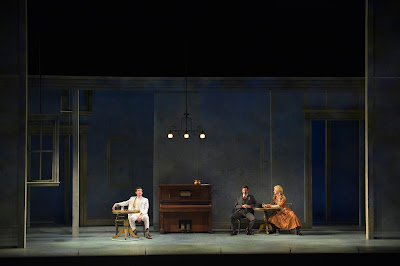A Lens on Small Town America: An Interview with Scenic Designer Ralph Funicello
By Cecilia Padilla
Despite
its title, Eugene O’Neill’s Ah, Wilderness! does not take place in the
wild outdoors. Instead, it depicts the home of a tight-knit Connecticut family.
Bringing the world of small town America to San Francisco audiences is scenic
designer Ralph Funicello, a longtime designer of A.C.T. productions.
This
will be Funicello’s second time working on Ah, Wilderness! with A.C.T.—
he also designed the set in the 1978 production. Then, Funicello’s designs
adhered to O’Neill’s textual specifications, exhibiting realistic styles and
period-appropriate architecture. This time, he’s approaching the play through a
new lens. “O’Neill literally dreamt up Ah, Wilderness!,” he says, “so I
want the audience to fall into the dream with him.”
 |
| Ralph Funicello's stage design in the current A.C.T. production of Ah, Wilderness! at The Geary Theater. Photo courtesy of Kevin Berne. |
What research has
contributed to your scenic design?
I
still have some of the books that I bought when researching the 1978 A.C.T.
production, one of which is A New England Town in Early Photographs.
More recently, my wife was performing in a play in Connecticut, and I went to
visit her on her day off. We took a trip to the Monte Cristo Cottage, which is
O’Neill’s boyhood summer home. After that trip, I definitely had that research
in the back of my mind.
What other influences
have you drawn from?
I
grew up just north of New York, halfway between New York City and Connecticut. Ah,
Wilderness! takes place in a town similar to mine. I was born in the 1950s right
after World War II, when the area where I grew up seemed like the world! This
play takes place on the Fourth of July, and I clearly remember what my hometown
felt like as a kid in the summer. There’s a sense of relief from school and an
elation for summer vacation. The Fourth of July celebrations in these small
towns were incredible—bunting and parades and lovely festivities. Also, the
winters in that area are brutal. I can only imagine what it would have been
like back in 1906, when New Englanders didn’t have central heating or
waterproof boots or nylon clothing. So by May, there’s this incredible release
when the weather gets warm.
What are you most
looking forward to regarding this production?
When
I went to college at Boston University, one of my teachers was the great
theater critic Elliot Norton. He was a personal friend of O’Neill. Elliot
Norton’s lectures on O’Neill are something I will never forget. He would go
into a trance and talk about O’Neill’s work and everything that influenced his
writing. It was wonderful. Elliot spoke about the development of the American
theater, and it struck me that American theater history is a chain of people
who can be traced back to O’Neill—and sitting in that classroom, hearing about
Eugene O’Neill from this great man, I became a part of that chain. Working on Ah,
Wilderness! allows me to be a part of Eugene O’Neill’s influence on the
American theater tradition.

